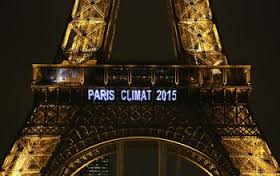 Earlier last week the co-chairs of the process to the Paris climate summit released the draft agreement and draft decisions for the outcomes of the meeting.
Earlier last week the co-chairs of the process to the Paris climate summit released the draft agreement and draft decisions for the outcomes of the meeting.
Below is a diagram that outlines, in simple terms, what these would mean for countries’ pollution reduction commitments. Note that this does not include other critical elements of the Paris outcome such as how to build resilience to growing climate change impacts and how to support the world’s poorest nations participate in climate change solutions (‘climate finance’).
While critical details remain to be resolved, the draft texts highlight that the contours of the Paris agreement are becoming increasingly clear. The inevitable trend to stronger action is embedded in the draft agreement with countries needing to progressively strengthen action through time.
Before getting into the details of this figure, and what it means for Australia’s target, a few overall elements of the draft agreement are worth highlighting:
- The draft makes it explicit that countries agree on the goal of limiting global warming to less than 2oC above pre-industrial levels. It includes options on how to recognise that most nations would like to see this goal strengthened to <1.5 oC, and options for a global long-term emissions goal set to, for example, zero net pollution this century.
- The draft agreement specifies that all countries are to have targets and that they are to be implemented at a national level. The targets would not be legally binding but the requirement to have them and implement actions to meet them would be.
- Each target that countries set should be a progression of action (i.e. stronger than the last one). As set out in decisions in Lima last year, countries will be expected to justify their targets in terms of being a fair contribution to the <2 oC goal. This is part of what is referred to as ‘up front’ information that countries should provide when communicating targets to the international community.
- In the future, all targets would be set for five-year periods. This avoids the current inconsistency of some countries announcing five year targets from 2020-2025 (like the USA) and others announcing 10 year targets from 2020-2030 (like China).
- Each country is invited to develop long-term low emission plans by around 2018. In practice, this is to encourage countries who have not set long-term emissions targets or pathways to net zero emissions to do so. The Australian government has stated it will consider a long-term target in 2017-18.
- The draft agreement provides for a regular global ‘stocktake’ of individual and collective action towards the <2oC goal. The draft decision which accompanies the draft legal agreement also contains an option to have a stocktake before 2020, and to undertake a review of the currently proposed targets over the period to 2017. Overall, these processes create global political moments where countries face public and diplomatic pressure to increase action. Australia should be supporting these options in the final Paris outcomes.
- The draft sets out that, from 2020, a unified or robust system of transparency will be implemented for all countries. This is one of the weaker areas of the draft as it vague on the principles that would underpin the development of this system. This should be a priority for negotiations in advance of Paris, and an area which is a welcome priority for the Australian government.
The way this system could operate in practice is set out in the figure below. Solid boxes are outcomes that have clear parameters in the drafts. Outcomes in dashed boxes either require greater clarity or don’t currently have broad consensus among countries. It illustrates:
- the legal process for the agreement to become international law. After the agreement is completed in Paris, countries will need to ratify the outcome. Once a certain number of countries have done this, the agreement will enter into force. Once the agreement enters into force, a new formal body will be established to implement the agreement and make decisions on the rules which cover international cooperation after 2020. To ensure rules are further developed in advance of entry into force, a preparatory decision-making body would be established to work on these details.
- how current post-2020 targets will evolve through time. This is underpinned by the development of long-term emissions pathways.
- identifies possible review points at which the global stock of actions will occur. It is around these times that new or updated targets would be advanced by all countries.
- shows how a system to ensure international transparency of domestic action would underpin national target setting. This has two elements. The first, set out by the current agreement in Lima, addresses the upfront information that countries are expected to include in their announced targets to ensure clarity and comparability of the contributions made. The expectation is that this information would be enhanced, with scientific inputs, by the time the agreement enters into force. The second element addresses the way countries measure, report and verify (MRV) their actions, including reporting national emissions, tracking progress through time and examining the impact of domestic policies.
Finally, the figure also indicates the points in time when Australia will have a formal opportunity to update its current post-2020 target and make it more credible. Note that any country can strengthen its target at any time. This figure simply indicates the points in the process when political pressure will be on Australia to finally do its bit towards global action to limit warming to less than <2oC.
Erwin Jackson is deputy CEO of The Climate Institute.











